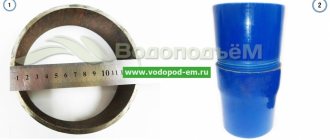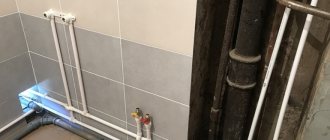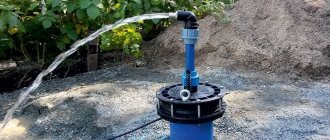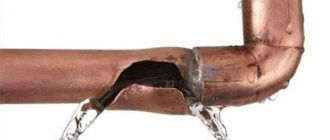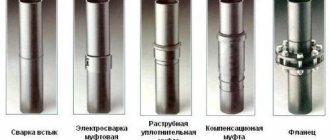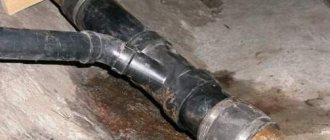The best way to ensure access to spring water is to have a water pot at home. But his work also involves the need to replace pipes or clean them. Drilling a water-bearing well on a site is relevant in many country houses. But problems can arise with the source both during drilling and during operation. What to do if the casing needs to be replaced or completely moved? How to pull a pipe out of a well with your own hands? This is one of the most difficult issues facing land owners.
It is necessary to remove the old casing pipe for various reasons and there are several methods for this.
Characteristics of casing pipes
Casing pipes are a special type of rolled material that allows you to strengthen the walls of wells, for which the pipe must be laid below ground level. Considering the operating conditions of casing pipes, we can safely say that they require special characteristics. In particular, the pipe must be able to withstand negative temperatures, resist corrosion and allow water to pass through.
All the described properties are inherent in pipes, the production of which is regulated by GOST 632-80. According to this regulatory document, seamless steel products are used as casing pipes, the diameter of which can vary from 114 to 508 mm. The end of the pipe must have a triangular or trapezoidal thread.
In addition to steel pipes, plastic seamless pipes made in accordance with the requirements for casing pipes can be used to strengthen the walls of wells. Polymer products can compete on equal terms with steel counterparts in terms of strength, and in other parameters they even surpass them.
What is the problem?
A water well is a similarity to an ordinary well, the diameter of which is small, but the depth can reach several tens of meters. To protect the walls of the well from a possible collapse of the soil, a casing pipe is driven into them. And so that the water remains clean and fresh, another one is inserted into the casing - an operational one. Of course, the diameter of the production pipe should be somewhat smaller than that of the casing. Often, in order to save money, they use pipes that can simultaneously perform both functions: strengthen the soil and contact with drinking water.
Well pipes are made from various materials:
- steel: the strongest, most durable and expensive;
- asbestos-cement: quite fragile, but quite high quality and relatively cheap;
- plastic: a new product on the market that is stronger than asbestos-cement products, has low weight and is cheaper than steel.
Please note: Removing fragile asbestos-cement pipes from the well without damaging them is an almost impossible task.
Pulling out a pipe is sometimes more difficult than drilling a well again.
In order to remove a narrow pipe from a well from a sufficiently large depth, considerable effort and skill will be required. In this case, it is necessary to take into account:
- the material from which the pipe is made;
- immersion depth;
- lifetime;
- Terms of Use;
- reasons for dismantling.
In some cases, it is not possible to successfully resolve the dismantling task, for example, when a structure breaks at great depths.
The need to dismantle pipes
In most cases, there is simply no need to remove pipes from the well. The fact is that after dismantling the pipes, the well is very likely to move or collapse.
Taking this factor into account, we can draw a fairly simple conclusion: before pulling the casing out of the well, you need to have complete confidence that this well will no longer be needed, and the risk of losing it is completely justified.
The need to create a new well arises for a number of reasons. For example, if the quality of the water in the old one has deteriorated after contact with the pipe, or if the casing pipeline is clogged. In other cases, you can use polymer liners, the diameter of which corresponds to the diameter of the pipes installed in the well.
What is a "fishing tool"?
Emergency work to remove stuck fragments of rusted pipes, pumps, large objects at the bottom of a deep and narrow well, borehole or abandoned column is carried out using 2 types of fishing tools:
- mortise bells for external grip;
- rifled pipe traps.
When eliminating accidents in wells, a fishing tool is used, one of the options of which is a bell
You can remove the old pipe from the well in parts or as a whole. But it is taken into account that a formation rupture, a vertical displacement of the well, or a seasonal disruption of the water circulation inside it is possible, which complicates the excavation of casing columns.
Fishing bells (pipe catches) are either through or non-through. The specificity of a through bell involves passing through its base the damaged fragment to be recovered. Next, external equipment (threaded couplings) make a notch in order to reach the removable riser. External pipes are also pulled out using taps.
Pipelines have different designs:
- collet type;
- sleeve and die;
- combined.
It is possible to use fishing cutters to lift up fragments stuck in an inclined well. This equipment allows for gripping by cutting into the extracted pipe. If column fragments are jammed, they are removed from the wells using hydraulic jars that create vibrating impacts. This tool is most often used by professionals from specialized companies.
Removing pipes by stretching
This technology is optimal for extracting pipes with large diameters and is used in cases where the well passage has been bent.
The work algorithm looks like this:
- The top edge of the casing is grabbed and pulled upward;
- You have to pull the pipe carefully and step by step, since a lot of force is generated in the process, as a result of which the pipe bursts at an arbitrary point in time;
- The broken pipe is picked up using a special nozzle and pulled until the next break.
By repeating this algorithm the required number of times, you can completely pull the pipe out of the ground. Before removing a plastic pipe from a well, you need to take a tool that creates enough force to remove the pipe. And, of course, after repeated breaks the pipe will become completely unsuitable for further use.
How to remove the outer pipe from a well that has expired?
This issue cannot be solved without special devices and equipment traditionally used to pull out the external (casing) pipe. Cylindrical fragments can be obtained from deep wells using so-called “pipe traps.” A winch and heavy-duty jacks may also be needed. You also need a flooring for support, consisting of beams, rails or metal beams.
To remove the pipe, you will definitely need lifting equipment, such as a winch.
When working with a jack, it is important to prepare the wellhead in advance to ensure access and ease of removing the pipes. The simplest way to remove damaged elements involves using:
- metal clamps.
- swivel plugs;
- metal bars;
- welding machine;
- jack.
Hydraulic equipment with a jack is mounted above the prepared well mouth. The pipe gripping tool is then installed by attaching special clamps. When the grip is organized correctly, removing the casing using a jack is not difficult. The remainder of the pipe that does not need to be removed can be cut on site using a welding machine. The extracted parts are stored in a pre-prepared place, from where they can be easily loaded and removed.
Note! To simplify the removal of pieces of equipment, it is advisable to think through this process at the stage of laying the well. Before pulling the casing out of the well or removing pieces of damaged equipment, it is important to measure the depth of the well.
How to pull it out using the walking method
This method can be used to pull out narrow pipes, but there is no guarantee that it will be possible to save it in this case. However, if the diameter of the pipe is sufficient to place a circulation pump in it, then there is a chance of removing the pipe without damaging it.
The process itself is quite simple and boils down to increasing the moisture content of the soil around the pipe. Softened soil does not provide a high enough coefficient of friction, so the pipe becomes much easier to remove using a tensioning device.
To implement this method, you need to fix the pump on the upper edge of the casing or immerse it inside the structure. After starting the pump, the pipe must be gradually walked around - that is, twisted and pumped in different directions. As a result of pacing, the density of the connection between the pipe and the ground decreases.
Possible alternatives
A specialist who is approached with a question about how to get a pipe out of a well will definitely ask a counter question: why? Some owners of private houses think that this is the only way to restore the operation of an old, abandoned or improperly installed well. Sometimes the desire to dismantle a pipe is dictated by the need to repair or replace a failed structure.
Since the dismantling process is labor-intensive, troublesome, long and expensive, you should definitely look for alternative solutions. For example, a smaller diameter production structure can be driven into a damaged casing pipe. The crack will be reliably closed and the well's operation will be restored.
Consultation with experienced specialists can be useful. Sometimes it is enough to properly clean the well and dismantling is simply not necessary.
In some cases, it turns out that it is cheaper and easier to drill a new well than to restore an old one.
Removing the pipe by unscrewing
To unscrew the pipe from the well, a special drilling rig is required. Removing casing pipes from the well in this case comes down to the simultaneous application of tension and rotation forces, which makes it possible to untwist the pipeline and pull it out.
First of all, a special bit is inserted into the well. The upper part of the pipe is clamped in a stationary state, the crown makes at least 20 revolutions in a counterclockwise direction, after which the pipe can be removed. During the work, you need to clearly control the applied forces - if they are excessive, the pipe will rupture.
Conclusion
This article answers the question of how to remove a pipe from a well with your own hands. There are several methods suitable for solving this problem, so you should first thoroughly study the problem, and only then begin to remove the casing pipes.
Main stages of work
The first step is to drill a hole in the buried pipe with a drill or screwdriver. Then we extend the steel cable into this hole.
Well, then everything is very simple: we install a rack jack nearby, hook the cable to the lifting arm, and slowly pull the pipe out of the ground.
Quick, simple and without any excessive physical effort. So take note of this method - it may come in handy someday.
You can watch the video on our website for details on how to remove a piece of metal pipe tightly driven into the ground. The idea itself was proposed by the author of the YouTube channel “ Mikha Nivovod ”.
Examples of completed objects
see all
Installation of sheet piling fencing at wastewater treatment plants of apartment buildings
In 2021, our company installed sheet piling fences at the wastewater treatment plant of a residential multi-apartment building in the village of Rasskazovka
26.06.2016
see all
North-Eastern section of the third interchange circuit
A set of works for the installation of sheet piling to a depth of 14.5 m
5.05.2016
see all
Design and installation of sheet pile fencing made of pipe and pile piles during the construction of a shopping complex.
Our company took part in the construction of an administrative and shopping complex with a parking lot in the city of Zhukovsky, Moscow region.
02.06.2016
see all
Sheet piling fencing of a pit during the construction of a multi-storey residential building
Our specialists carried out comprehensive work on the installation of sheet piling fencing for a pit during the construction of a multi-storey residential building with an underground parking lot and built-in public premises
6.07.2016
see all
Supply, installation and removal of sheet piles during the reconstruction of a sewage pumping station
Our company installed sheet piling during the reconstruction of a sewage pumping station in Shcherbinka (Moscow region).
26.06.2016
see all
Installation of sheet piling from Larsen sheet pile using vibration immersion method
Installation of sheet piling from Larsen sheet piling using the vibration immersion method at the construction site of an administrative building in Moscow, on the street. Baikalskaya, 42.
14.07.2017
We know everything about sheet piling
Work experience - 10 years. More than 270 completed projects. Not a single negative review.
For any questions call: 8 800 707-72-09
Possible reasons
The most common reason that equipment gets stuck in a well is human error. This can be either a violation of technological requirements during the installation process or the quality of installation materials
It is very important that during the installation process you choose proven equipment, and the installation itself is carried out by qualified specialists
But improper installation and poor-quality equipment are only factors influencing the causes themselves. Let's look at why the pump may get stuck in the well below.
Slack cable
A slack cable is one of the most common reasons why pumping equipment can get stuck in a well. If the electrical cable is slack, it may simply get caught in the loop of the cable that holds the equipment. When this happens, in no case should you pull the cable with all your might, as you can tear it off, and it will be much more difficult to remove the pump from the well yourself.
It is worth noting that this is the most common and quickly solved problem. If the pump stalls and does not go up, try lowering it a little, and choosing the moment when the cable loosens, repeat the rise. During the process, make sure that the cable, cable and hose do not sag.
In order to avoid such troubles in the future, simply connect the cable to the hose with clamps, securing it. During the lifting process, make sure that the cable and hose come out at the same time, and do not allow slack, as the situation may repeat itself.
Siltation of the well
Quite often, the reason that it is not possible to pull the pump out of the well is that it has become silted due to infrequent use. It is the layer of silt that serves as an anchor that prevents you from pulling out the pumping equipment.
If the cause is silting, you can try to get it out by rocking it, slightly lifting and lowering the pump down. Under the influence of mechanical movements up and down, the water will erode the space around the pump, thus facilitating its release.
If the pump is stuck, it is important not to rush into the swinging process and not to pull with all your might, as it may completely jam or the cable may break completely. If you can’t get the pump yourself, you can resort to the help of firefighters, so that they lower the fire hose and wash away the layer of silt with water pressure
Reverse siltation
One of the reasons for a pump jamming in a well may be the effect of reverse siltation. It’s worth noting right away that it is observed only in wells drilled on limestone soils, so if your well is not on limestone, this option can be excluded.
Jamming of pumping equipment occurs due to the deepening of the pump during operation. Over time, sediment forms and settles on the pipes and pump.
It is important to note that you will not get away with flushing the well, as in the previous option, since the sediment can be very dense. In this case, you can pull out the pumping equipment by rocking it up and down, after turning it on
Damage to pipe walls
Damage to the walls of the casing is a fairly rare reason for the pump to get stuck. But, nevertheless, it should be considered. If, while lifting the pump up, you encounter an obstacle and hear a knock, then most likely the problem is in the casing. This can be either its deformation (plastic), formed during the process of soil displacement, or defects in welding and pipe connections. In this situation, you can remove the pump from the damaged pipe using rotational movements. By rotating the pump in a circle, you have a chance to go around the obstacle.
Limescale deposits on casing pipes
Another obstacle to lifting the pump can be an object accidentally falling into the pipe. If it gets into the space between the pump and the well, it can stop the rise. In such a situation, as a rule, the downward movement is free, but when moving up, the pump begins to jam. Try to rotate the pump and lift it up again. If there is no positive trend, it is better to call specialists who have all the necessary equipment to fix the problem and raise the pump.
Advice from craftsmen
Often, in order to get stuck pumping equipment, many people use, although effective, but rather dubious methods:
- Use a metal cat. Although this method has some effectiveness, it should not be used. Firstly, hooking the pump is quite problematic; most likely, you will catch the hose. And secondly, if the cat breaks, you will subsequently have to get it out too.
- They use a crowbar. In order to push pumping equipment into the well, scrap metal is often used, first secured with a cable. It must be taken into account that if the crowbar breaks, it is almost impossible to get it out. Of course, one should not expect normal operation from such a well in the future. Instead of scrap, it is better to use a metal pipe, having previously welded ears to it.
You can also pull out the pump by tapping the cable. To do this, the cable must be constantly kept under tension and constantly tapped. Theoretically, if the pump is not completely jammed and there is no obstacle in its path, the effect will be positive, but this may take a long time.
